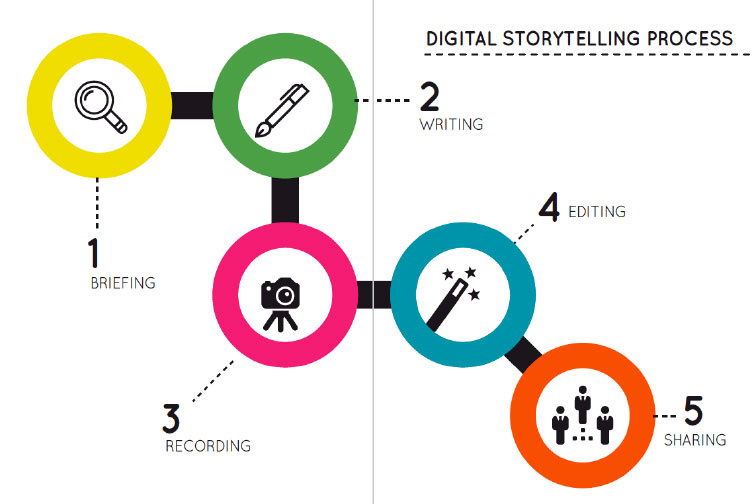Digital toolbox
Full digital storytelling process

The hybrid nature of the Digital Storytelling (DS), combining narrative/creative processes and use of technology to actual develop the final output, makes it a powerful and flexible tool for participatory action research and to build social empathy.
There is a variety of ways in which the DS method has been put into practice worldwide, but generally speaking, the DS process follows 5 steps as illustrated below:
1. Briefing and Story-circle
In this phase participants are introduced to the elements of a Digital Story and receive a clear explanation of the process and timescale involved. It is generally recommended to send in advance some preparation notes, so to enable participants to maximize their experience during the workshop. After the briefing, the actual storytelling process starts with a story-circle, during which participants come together (ideally in groups of 8-10 for each facilitator) to start sharing verbally their first concept of a story.
2. Writing
The transition from a story told during the story-circle to an actual script happens in this step. The duration of this session can vary depending on how prepared participants come to the workshop – i.e. if they had or hadn’t already drafted a script (this might be asked in the preparation notes). The ultimate goal of this phase is to get scripts finalized ready for voice recording. Generally we suggest writing stories with no more than 250 words, so to generate a voice-over of around 2 minutes.
3. Recording
This is the point at which the technical elements of DS start appearing. Participants are helped by the facilitator record their voice-over (while reading the script) and edit the audio file. Both the technical quality of the audio and the ‘feel’ of the voice are crucial in the “making” process.
4. Editing
During this phase, participants are guided in using video-editing software to combine the edited soundtrack with other sounds effects, personal photographs, other visual materials, titles, etc.
It’s predominantly a technical process but the creative aspects and the collaboration among participants are fundamental.
5. Sharing
Generally, each DS workshop ends with a screening session, during which participants present the video they make and share reflections on the process, giving each other feedback. As we are talking about a “digital object” is important to reflect also on the implications of sharing the story with a larger audience, if/when the video is published on the web.